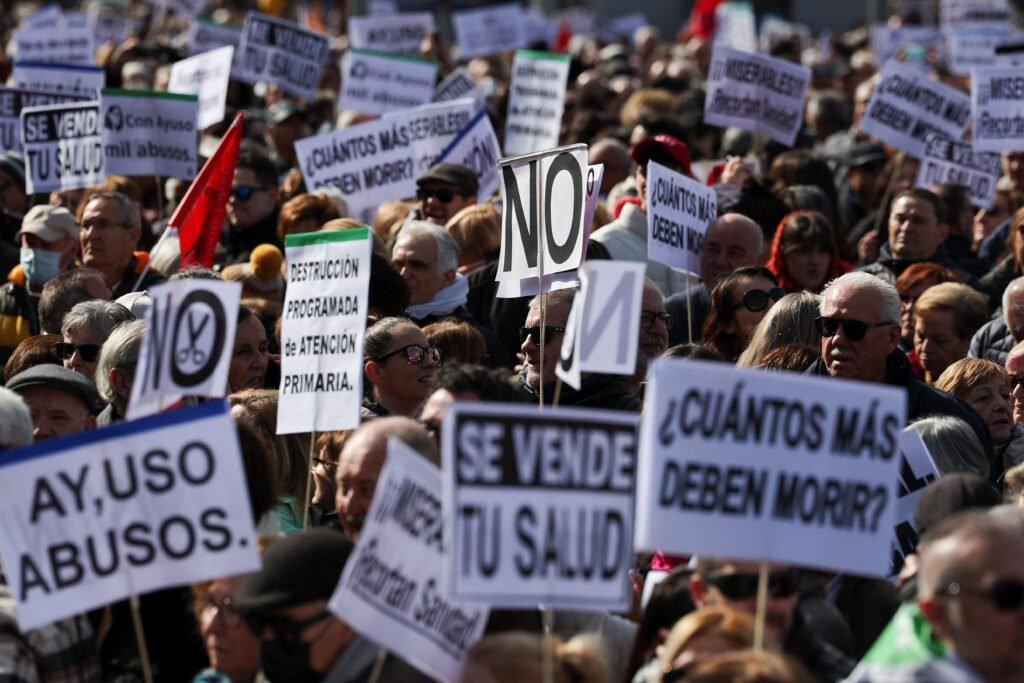The recent demonstrations in Madrid highlight a growing dissatisfaction with the public health system, which has been deeply impacted by privatization policies and cutbacks initiated by the right-wing Ayuso government. On Sunday, over one million people took to the streets to express their outrage, with organizers reporting a turnout significantly larger than the police estimate of 250,000. These protests are part of a broader movement that has spread across Spain, with large-scale demonstrations also occurring in regions like Galicia and Castile and León, both governed by right-wing parties.
The ongoing degradation of Madrid’s public healthcare system has been well documented. Access to primary care has deteriorated, with wait times for appointments averaging nine days. Madrid spends the least on public healthcare per capita, and of the 78 out-of-hospital emergency centers in the region, only 24 have reopened since the pandemic, and even these are understaffed. Additionally, primary care physicians are burdened with up to 70 patients a day, far above the international recommendation of 25. Meanwhile, private healthcare spending has steadily increased, exacerbating the inequalities in access to quality medical services.
These demonstrations must also be understood within the broader context of mismanagement during the COVID-19 pandemic. The scandal surrounding the deaths of over 7,000 elderly residents in care homes, left to die under appalling conditions, remains a painful reminder of the government’s negligence. Moreover, the construction of the Zendal hospital, which cost €160 million but has proved largely ineffective, and the €283,000 profit made by Ayuso’s brother in mask procurement during the pandemic, have only fueled public anger.
While the immediate target of these protests is Ayuso and her government, the issue extends far beyond one administration. The problems facing Madrid’s healthcare system are symptomatic of the broader failings of capitalism, which prioritizes profit over public well-being. Privatization and austerity measures, driven by capitalist interests, have eroded essential services, leaving working-class families to bear the brunt of the consequences.
Over the past few months, the response from working-class neighborhoods and healthcare workers has been resolute. Assemblies representing 93 different communities have united, with healthcare professionals, including family doctors and pediatricians, leading the charge through strikes and public protests. The mass mobilization of working families, which was evident during the November protests and again this Sunday, shows that the fight for public healthcare is far from over.

The movement’s goal must not only be the removal of Ayuso from power but also the reversal of her policies and the fight against the underlying capitalist structures that have driven these destructive reforms. The anger directed at Ayuso must be channeled into a broader struggle against capitalism itself, as it is this system that perpetuates inequality and denies basic rights to the working class.
The significance of these protests is underscored by the stark contrast between the overwhelming support for public healthcare reforms and the comparatively small turnout for right-wing rallies, such as the one organized by the PP, Vox, and Ciudadanos in Plaza de Colón on January 22. While the right-wing mobilization was planned for two months and drew people from across Spain, it only managed to gather around 30,000 to 40,000 attendees. In contrast, the grassroots movement defending public healthcare in Madrid has drawn hundreds of thousands of local participants.
The superiority of this movement is not just a matter of numbers but also of its social composition. On one side are the working-class families, healthcare workers, students, and young people fighting for a fair and just society. They represent the vibrant and productive forces of the community. On the other side are the elites—the landowners, rentiers, and other figures of power—who seek to maintain their control and profit from the labor of others.
The ongoing fight for public healthcare represents more than just a campaign for better medical services; it is a reflection of the broader struggle against the inequalities perpetuated by capitalism. A fully functioning public healthcare system, one that offers decent care and working conditions for all, cannot exist within a society that prioritizes bank profits, military spending, and tax breaks for the wealthy over the needs of the population. As long as these priorities remain, true reform will be impossible.
The mobilizations must continue, with the ultimate goal of reversing all privatization measures, reclaiming hospitals from private operators, and redirecting public funds toward improving healthcare services and wages for workers. The structures needed to bring about this change are already in place, with organized and fed-up working families leading the charge.
The working class, together with healthcare professionals and students, has the strength and determination to demand the systemic changes necessary for a just and equitable society. The ongoing struggle must push beyond Ayuso’s removal and target the capitalist structures that have allowed such degradation of public services to occur. The fight for healthcare is a fight for social justice, and it will only be won through continued organization and mass mobilization.


